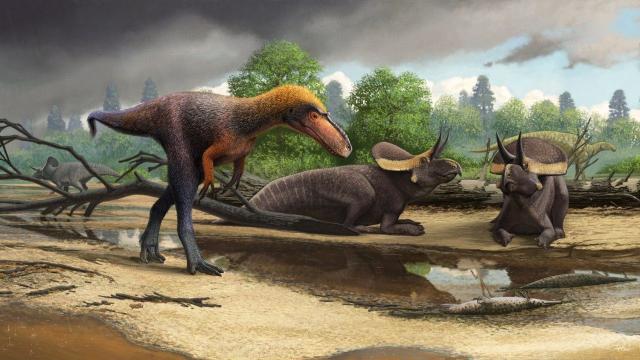Paleontologists have identified a previously unknown relative of T. rex that stood just below 0.91m at the hip. The discovery is shedding new light on the evolutionary origins of tyrannosaurs, while providing a glimpse of these fearsome creatures before they reached enormous sizes.
New research published today in Nature Ecology & Evolution describes Suskityrannus hazelae, a species of tyrannosauroid dinosaur. This creature lived during the Middle Cretaceous Period some 92 million years ago, which was about 27 million years before the rise of Tyrannosaurus rex. Suskityrannus is not a direct ancestor of T. rex, but its discovery fills a critical gap in the fossil record of tyrannosauroid dinosaurs, as only a few species of tyrannosauroids are known between the Early Cretaceous and the Late Cretaceous.
A quick note about terminology. All tyrannosaurids are tyrannosauroids, but not all tyrannosauroids are tyrannosaurids; the tyrannosaurid group of dinosaurs sits within the larger tyrannosauroid group. Gigantic tyrannosauroids such as T. rex and Albertosaurus are tyrannosaurids. The authors of the new study, led by Virginia Tech paleontologist Sterling Nesbitt, categorized Suskityrannus as a non-tyrannosaurid tyrannosauroid. What makes this new dinosaur special, however, is that it’s more closely related to T. rex and other tyrannosaurids than to other early Cretaceous tyrannosauroids.
The name Suskityrannus hazelae is derived from the local Zuni word for coyote, the Latin word “tyrannus” meaning king, and from the name Hazel Wolfe, a supporter of fossil expedition in New Mexico.
Suskityrannus was around 2.7 to 3.6 meters long, it stood from 0.6 to 0.9 meter at the hips, and it weighed no more than 40 kilograms. Its skull measured around 32 centimeters in length. To put this creature’s size into perspective, it was just slightly longer than the skull of a fully grown T. rex.
The newly described species is known from a pair of juvenile skeletons, which were found about 165 feet (50 meters) from each other in the Zuni Basin of New Mexico. The first skeleton was discovered in 1997 by Robert Denton, who’s currently a senior geologist with Terracon Consultants. The second, more complete skeleton was discovered by Nesbitt in 1998. Remarkably, Nesbitt was a 16-year-old high school student at the time, and he found the bones while participating in a paleontological expedition led by Doug Wolfe, a co-author of the new study and a paleontologist at the Zuni Dinosaur Institute for Geosciences.
For years, the scientists weren’t sure with what they were dealing with, figuring the remains belonged to some kind of dromaeosaur, like a Velociraptor.
“We did not know these fossils represented a tyrannosauroid for more than a decade after they were discovered,” Nesbitt told Gizmodo in an email. “It was after many new, small tyrannosauroids from China and North America were found that we could compare our specimen to these others.”
And indeed, the discovery connects older and smaller tyrannosauroids from North America and China with the enormous tyrannosaurids that emerged during the Late Cretaceous.
“Suskityrannus helps us constrain the time that large tyrannosauroid dinosaurs got big—sometime after approximately 92 million years ago—and became the biggest meat eaters at the time,” said Nesbitt. “More broadly, tyrannosauroids go back to the Middle Jurassic, around 160 million years ago, but it is only at the end of the Cretaceous that they got big.”
Nesbitt said the new dinosaur fills an important evolutionary gap, but it would be a mistake to call it a “missing link.” Suskityrannus “represents a side-branch of the [tyrannosauroid] family” and is “not a direct ancestor” of T. rex and other big tyrannosaurs, he said.
In terms of its unique physical characteristics, the bipedal Suskityrannus had long feet, a strong bite, and sharp, serrated teeth—features consistent with a fast-moving carnivore. It likely lived in a wet, swampy environment and feasted on hadrosaurs, ankylosaurs, and other prey, according to Nesbitt.
A decent portion of the skeleton was represented in the two specimens, but some parts of its skull, hands, and feet were missing. Scientists don’t know if Suskityrannus had small arms like T. rex or if it had two or three fingers.
In an email to Gizmodo, paleontologist Thomas Carr from Carthage College said an added bonus of the new study is that Suskityrannus is represented by “more than one scrappy skeleton.” The finding is important, he said, because it shrinks the time gap between the small, intermediate-grade tyrannosaurs and the big ones. But that still means a 12-million-year time gap exists between “the first of the big tyrannosaurus and the ancestral representatives of the two main stocks of the giants, namely the Albertosaurus line and the tyrannosaurine line,” said Carr, who was not involved with the new study.
For Brown University PhD candidate Armita Manafzadeh—also not affiliated with the new work—the most interesting aspect was the “arctometatarsalian” foot, which she said is “secretly the most exciting part of this paper.”
“In an arctometatarsalian foot, the three long bones that make up the sole of the foot are pinched together, with the middle bone being particularly skinny. Most dinosaurs and other reptiles have roughly cylindrical sole bones like us,” wrote Manafzadeh in an email to Gizmodo. “This foot morphology has only been found in a few groups of Cretaceous theropod dinosaurs, and several biomechanical hypotheses have been put forward linking it to improved running ability.”
The new paper is thus significant in that “the foot of Suskityrannus is now the earliest known record of an arctometatarsalian foot in a tyrannosauroid,” a discovery that “has the potential to help us better understand the evolution of running ability in dinosaurs,” she said.
